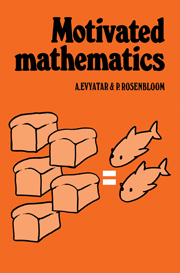Preface
Published online by Cambridge University Press: 20 March 2010
Summary
Many distinguished mathematicians and educators, going back at least to F. Klein and E. H. Moore about 80-90 years ago, have advocated that mathematics should be taught in close connection with its applications and be motivated by them. The critics of the reforms in the United States’ secondary school mathematics curriculum in the 1950s strongly emphasized this view, but produced very little concrete material for school mathematics showing how mathematics can be applied. Up to that time the only applications which were treated in school mathematics were consumers’ and shopkeepers’ problems.
In 1963, Professor Paul Rosenbloom, then Director of the Minnesota School Mathematics and Science Center, produced a first draft of a course on computer and applied mathematics for the twelfth grade. The mathematical topics were chosen in accordance with the recommendations of the Commission on Mathematics of the College Entrance Examination Board (C.E.E.B.). However, the treatment of topics in the course was original, and different from, for example that of the School Mathematics Study Group; each topic was motivated by beginning with a concrete application to the natural or social sciences whose investigations would lead to that topic. A source of inspiration for the course was the book by Th. von Karman and M. Biot, Mathematical methods in engineering (McGraw-Hill, New York, 1940).
For several years, beginning in 1963, summer institutes for high school teachers and students were conducted at the University of Minnesota. The two groups were taught together so that the teachers could observe the students learning. Besides the material on applied mathematics, the two groups were given courses in computer programming and numerical analysis, and a seminar in problem solving.
Information
- Type
- Chapter
- Information
- Motivated Mathematics , pp. vii - viiiPublisher: Cambridge University PressPrint publication year: 1981
